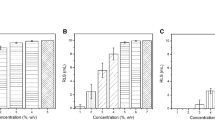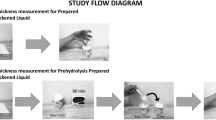Abstract
Powdered thickeners are used to modify drink consistency in the clinical management of dysphagia. These thickeners are composed of primarily modified maize starch; some varieties also incorporate powdered gums. Amylase is a digestive enzyme found in saliva that initiates the breakdown of starch. To determine the significance of this process in dysphagia management, we measured the effects of human saliva on the viscosity of thickened drinks. Two thickeners were studied: one comprising modified maize starch alone and one that included additional gums. These were added to drinks with neutral and acidic pH: water and orange juice. Two clinical scenarios were simulated: (1) the effect of saliva on fluid as it is swallowed and (2) the effect when saliva enters a cup and contaminates a drink. Saliva was found to reduce the viscosity of water thickened with maize starch in both scenarios: (1) 90% reduction after 10 s and (2) almost 100% reduction in viscosity after 20 min. The thickener composed of gums and maize starch showed a significant reduction but retained a level of thickening. In contrast, thickened orange juice (pH 3.8) was not observed to undergo any measurable reduction in viscosity under the action of saliva.






Similar content being viewed by others
References
Whelan K. Inadequate fluid intakes in dysphagic acute stroke. Clin Nutr. 2001;20(5):423–8.
Layne KA, Losinski DS, Zenner PM, Ament JA. Using the Fleming index of dysphagia to establish prevalence. Dysphagia. 1989;4(1):39–42.
Goulding R, Bakheit AM. Evaluation of the benefits of monitoring fluid thickness in the dietary management of dysphagic stroke patients. Clin Rehabil. 2000;14:119–24.
Finestone HM, Foley NC, Woodbury MG, Greene-Finestone L. Quantifying fluid intake in dysphagic stroke patients: a preliminary comparison of oral and nonoral strategies. Arch Phys Med Rehabil. 2001;82:1744–6.
Kayser-Jones J, Schell ES, Porter C, Barbaccia JC, Shaw H. Factors contributing to dehydration in nursing homes: inadequate staffing and lack of professional supervision. J Am Geriatr Soc. 1999;47(10):1187–94.
Dantas RO, Kern MK, Massey BT, Dodds WJ, Kahrilas PJ, Brasseur JG, Cook IJ, Lang IM. Effect of swallowed bolus variables on oral and pharyngeal phases of swallowing. Am J Physiol. 1990;258:G675–81.
Cichero JA, Jackson O, Halley PJ, Murdoch BE. Which one of these is not like the others? An inter-hospital study of the viscosity of thickened fluids. J Speech Lang Hear Res. 2000;43:537–47.
Miller JL, Watkin KL. The influence of bolus volume and viscosity on anterior lingual force during the oral stage of swallowing. Dysphagia. 1996;11:117–24.
Leonard R, Kendall K. Dysphagia assessment and treatment planning. San Diego: Singular Publishing Group A Team Approach; 1997.
Hamlet S, Choi J, Zormeier M, Shamsa F, Stachler R, Muz J, Jones L. Normal adult swallowing of liquid and viscous material: scintigraphic data on bolus transit and oropharyngeal residues. Dysphagia. 1996;11:41–7.
Dantas RO, Dodds WJ. Effect of bolus volume and consistency on swallow-induced submental and infrahyoid electromyographic activity. Braz J Med Biol Res. 1990;23:37–44.
Cichero JA, Murdoch BE. Dysphagia: foundation, theory and practice. Chichester: Wiley & Sons; 2006.
Hall JE. Guyton and hall textbook of medical physiology. 12th ed. Philadelphia: Saunders; 2010.
Logemann JA. Evaluation and treatment of swallowing disorders. 2nd ed. Austin: Pro-ed; 1998.
British Dietetic Association. National descriptors for texture modification in adults. http://www.bda.uk.com/publications/statements/NationalDescriptorsTextureModificationAdults.pdf (2009). Accessed 19 June 2009.
O’Leary M, Hanson B, Smith CH. Variation of the apparent viscosity of thickened drinks. Int J Lang Commun Disord. 2011;46(1):17–29.
Salimetrics LLC. Saliva collection and handling advice. http://www.salimetrics.com/spit-tips/publications/saliva-collection-handbook.php. Accessed 21 Feb 2011.
Fried M, Abramson S, Meyer JH. Passage of salivary amylase through the stomach in humans. Dig Dis Sci. 1987;32:1097–103.
Malkin AY. Rheology Fundamentals. ChemTec Publishing, Toronto. 1994.
Sopade PA, Halley PJ, Cichero JA, Ward LC. Rheological characterization of food thickeners marketed in Australia in various media for the management of dysphagia. I: water and cordial. J Food Eng. 2007;79:69–82.
Sopade PA, Halley PJ, Cichero JA, Ward LC, Liu J, Teo KH. Rheological characterization of food thickeners marketed in Australia in various media for the management of dysphagia. II. Milk as a dispersing medium. J Food Eng. 2008;84(4):553–62.
Sopade PA, Halley PJ, Cichero JA, Ward LC, Liu J, Varliveli S. Rheological characterization of food thickeners marketed in Australia in various media for the management of dysphagia. III. Fruit juice as a dispersing medium. J Food Eng. 2008;86(4):604–15.
Smith CH, Logemann JA, Burghardt WR, Zecker SG, Rademaker AW. Oral and oropharyngeal perception of viscosity across the age span. Dysphagia. 2007;21:209–17.
O’Leary M, Hanson B, Smith CH. Viscosity and non-Newtonian features of thickened fluids used for dysphagia therapy. J Food Sci. 2010;75:E330–8.
Author information
Authors and Affiliations
Corresponding author
Rights and permissions
About this article
Cite this article
Hanson, B., O’Leary, M.T. & Smith, C.H. The Effect of Saliva on the Viscosity of Thickened Drinks. Dysphagia 27, 10–19 (2012). https://doi.org/10.1007/s00455-011-9330-8
Received:
Accepted:
Published:
Issue Date:
DOI: https://doi.org/10.1007/s00455-011-9330-8




